The strategy determines the direction

Consulting | Strategy development
Giving orientation with the right strategy
- A strategy gives orientation to an organization and its employees.
- Does your strategy still meet the requirements of your company or department?
- Do you need support in developing and implementing a new strategy?
The more uncertain the future, the more important it is for a company to give orientation to its employees and its organisation. This requires a suitable strategy that gives employees the direction for their actions. We support you in developing the right strategy for your company, your division or your team, and implementing it successfully together with your employees.
A robust path for the future
We help you to formulate your vision and mission. The future strategy depends on this. In volatile environments, it should point the way forward. Together with your team, we describe the initial situation of your organization on the basis of selected analyses. The strategy is developed on this basis. We use various instruments such as the SWOT analysis or the scenario technique. In addition, we pursue participatory approaches such as cross-hierarchical and cross-departmental workshops, which have proven their worth in our many years of practice. This allows you to benefit from the expertise of your employees and at the same time increase the acceptance of the new strategy.
Trust our many years of experience in strategy development. We are happy to advise and accompany you in the development and implementation of your strategy.
Analyses, scenarios and levers
Since trend updates in complex situations are usually unreliable, we develop projections and scenarios with you. We work with your team to develop the initial situation of your organisation on the basis of selected analyses. In this way, a commitment about the levers and the way into the future is created in dialogue. This ensures energy and motivation during implementation. Adapted to your current question and starting position, we use the right methodology for you. An example of strategy consulting using the scenario technique can be found in this project report.

Meeting the concerns of stakeholders
Mission and values can be formulated in addition to the vision. The mission describes the promise of benefit: What do you offer your customers? What is the purpose of your organization? You can describe this purpose not only for your customers, but also for all other stakeholders. After all, every organization is intertwined with a wide range of stakeholders: Customers, employees, suppliers, partners, capital owners, the state, society, etc. How does your company meet these expectations and needs? The values of an organization form the guideline for its actions. Do the values only exist on paper or are they filled with life? The credibility in the implementation of the strategy strongly depends on whether the action is oriented towards the values. The following chart shows the essential elements of a strategy.

Strategy as a negotiation process
In dynamic environments, a strategy is decreasingly becoming an objective and reliable point of orientation. Rather, a strategy becomes an interpretive framework in which the corporate cultural assumptions and constructions are repeatedly negotiated anew. An unstable organizational environment means to regard strategy as a topic of the organizational culture.
This can be an important function for communication within the organisation.
Flexible implementation of the strategy
With a planned strategy you give the organization an orientation and direction for its actions. Henry Mintzberg describes what emerges in daily action and reaction to the demands and opportunities of day-to-day business as the emerging strategy. The real strategy is then always a combination of the planned and the emerging strategy. The strategy must therefore not be a concrete block that is immovable in every detail. You need the flexibility to be able to react to unforeseen developments. This is often described as the agility of the organization: Create a structure in which necessary changes are recognized and quick adjustments are possible. Therefore, it makes sense to create protected experimental spaces in which new ideas can be tried out without being exposed to the immediate pressure of results.
The instrument SWOT analysis
A SWOT analysis has proven effective in summarizing the key internal and external factors for developing a strategy. In order for a SWOT analysis to provide well-founded insights, thorough analyses are required. These analyses are based on data from the environment and internal company data. Strategic options for action can then be derived within the framework of the SWOT analysis.
From these options an effective strategy can be developed.
A detailed description of the SWOT method can be found on Wikipedia.

Participation strengthens implementation
Participation-oriented approaches have proven effective in promoting the implementation of a strategy. For example, you can involve managers and employees in the development of a strategy in cross-hierarchy and cross-departmental workshops. At the same time, you can benefit from the internal expertise of your own organization, as employees often have a good knowledge of their environment and can enrich the discussion with good ideas. But a look at the outside can also be helpful: What do start-ups do differently in your industry?
What success models are there in other industries?

